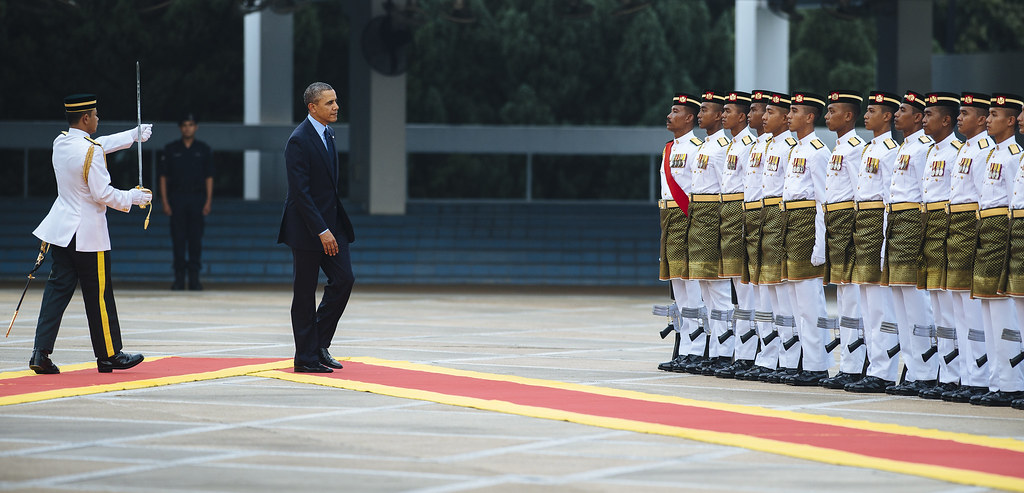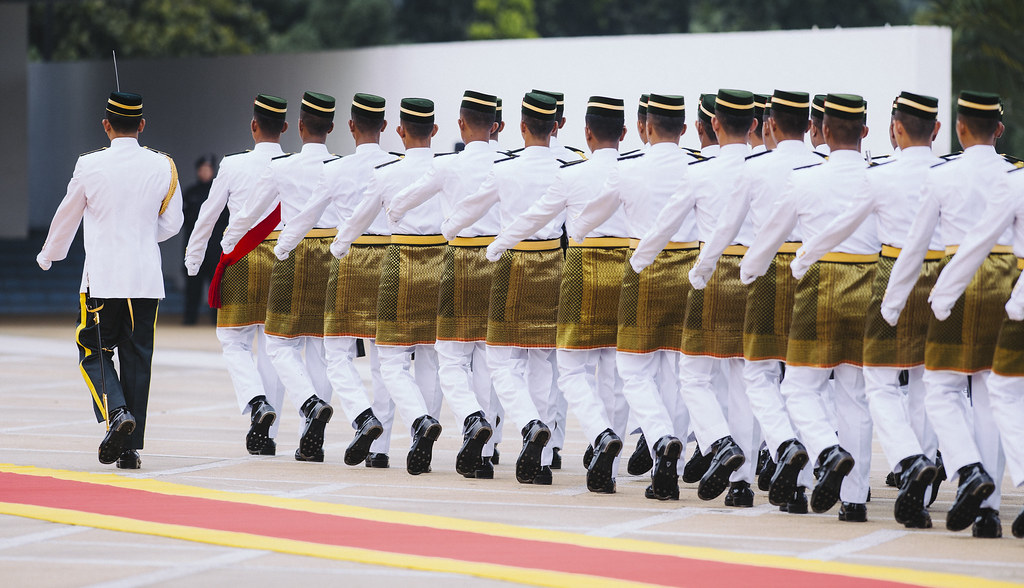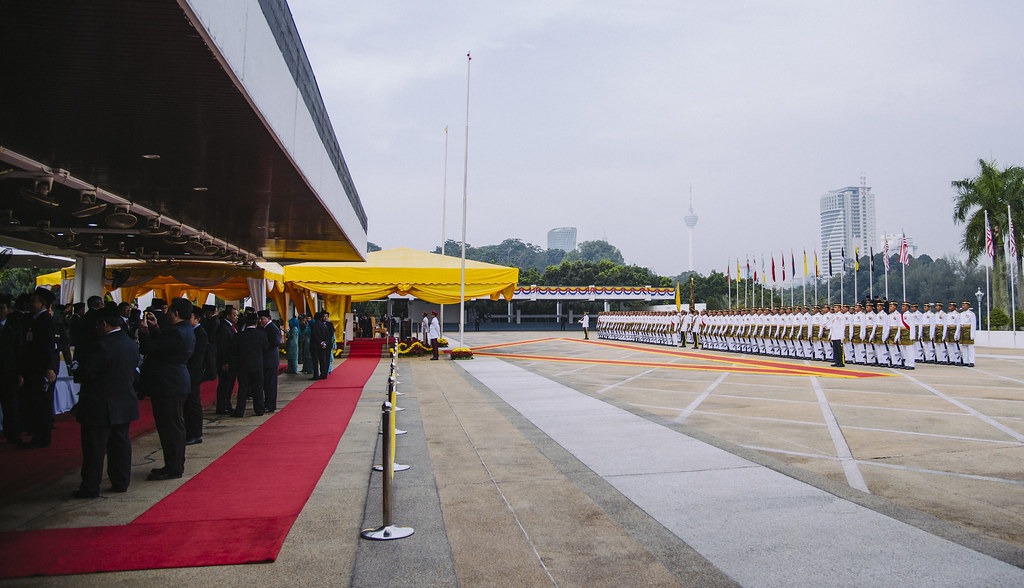Photojournalism | The Royal Malay Regiment and Barack Obama
© 2014 Wazari Wazir | US President Barack Obama Inspecting The Guard of Honour From The First Battalion of the Royal Malay Regiment, comprising four officers and 103 men, led by Major Amriza Mohd Asshari, During His Official State Welcoming Ceremony at Parliament House in Kuala Lumpur on April 26, 2014.
© 2014 Wazari Wazir | The Honour Guards From The First Battalion of The Royal Malay Regiment, Stand During a Welcoming Ceremony for United States President Barack Obama at The Parliament Square Kuala Lumpur, On April 26, 2014.
The Royal Malay Regiment (Malay: Rejimen Askar Melayu DiRaja; Jawi: ريجيمن عسكر ملايو دراج) is the premier unit of the Malaysian Army’s two infantry regiments. At its largest, the Malay Regiment comprised 27 battalions. At present, two battalions are parachute trained and form part of the Malaysian Army Rapid Deployment Force. Another battalion has been converted into a mechanized infantry battalion while the remaining battalions are standard light infantry.
The Honor Guard in Malaysia usually consists of the Royal Malay Regiments which performs most ceremonial duties in Malaysia such as Warrior’s Day, visitation of diplomats, National Day, guard duties at the Royal Palace of Malaysia and many more.
The 1st Battalion Royal Malay Regiment acts as the ceremonial battalion for the Yang di-Pertuan Agong, and is usually accompanied by the Central Band of the Malay Regiment. As its name suggests, the regiment only recruits ethnic Malays.
The Royal Malay Regiment or Askar Melayu was formed on 1st March 1933 with an “experimental” unit of 25 Malay recruits under a British officer. It was termed ‘experimental’ because at this stage, it was only an atttempt according to Maj.Gen. G.Bruce, OBE, MC (ret) to “find out how the Malays will react to military discipline.”
The British colonial administrators were reluctant and cautious about arming and training Malays for regular units, partly due to the belief that the Malays, with their laid-back, leisurely temperament and lack of military traditions were unsuitable for strict military discipline. But more importantly, the British were worried that the well-trained and well-armed Malays might be involved in rivalries among Malay chiefs for power and control of the lucrative tin-mining areas which were widespread in the Malay states. It was only in 1933 that the British finally changed their minds mainly because of the high costs of hiring the Burma Rifles from India.
Maj. G. Bruce, a liberal and a wise officer, was appointed by the British to be the first Commanding Officer. Although all military commands were in English, Malay was used widely for instructions. Bruce realised that this arrangement would assist many non-English educated Malays in their learning and it could thus train as many non-commissioned Malay officers to staff the new regiment as possible. British officers from the Commanding Officer downwards were expected to learn Malay and subsequently to know something about Malay customs and the Muslim religion. Maj. Bruce, for instance, took a short Malay language course. In addition, there was also the appointment of a regimental religious teacher in the unit.
Competitions were frequently held to get the best out of the men on parade and in the field. The instructors also aimed at developing in the Malay soldiers a sense of patriotism, a love for their country and loyalty to their rulers. Special attention was paid to food, social recreation and the general welfare of the soldiers.
In keeping the name “Malay Regiment”, efforts were made to retain the distinctive Malay character. Maj. Bruce conceived the idea of a Regimental mufti embodying the Malay national dress. He argued that for esprit de corps, British personnel serving in the regiment had to wear the Malay Regiment uniform which would identify them from the onset with the Malay Regiment rather than with their own British units. A regimental badge was created containing the motto: “Ta’at dan Setia” (loyal and true).
Three regimental colours were chosen for the regiment – green representing Islam, yellow for Malay royalty, and red for the British army. These unique uniform, motto and regimental colours were well accepted by members of the unit. As expected, the Malay soldiers responded “extremely well” and serious breaches of discipline were rare, according to its Commanding Officer. The high standard of training, sensitive and matured management must have contributed greatly to its special quality.
The Malay soldiers did not take long to prove themselves to be highly disciplined and credible fighting men. On 1st January, 1935, the “experimental” company became The Malay Regiment with a compliment of 150 men. Recruitment speeded up with another 232 recruits, 2 rifle companies were started and a HQ Wing that included a Vickers platoon, a signalling section and a corps of drums. Trained in Port Dickson, Malaya, the regiment also went through a 3-month attachment with the Royal Inniskilling Fusiliers in Singapore.
In 1936, advanced training for the regiment was carried out in Singapore from 1937 and again in January and February 1938 for drills in battalion and other military exercises. The performance of the Malay Regiment was so impressive that there was a call by the locals to establish a similar regular regiment in Singapore. As the shadow of war loomed larger, training was intensified. Long route marches – No.3 platoon of A company covered a record 104 miles in 4 days, 4 hours and 15 minutes, and exercises at battalion and brigade levels became frequent. The soldiers also began training with mortars and anti-tank weapons. They were also well know for their marksmanship.
The unit remained small until 1939, when it was expanded into the 1st Battalion of the Royal Malay Regiment (Rejimen Askar Melayu DiRaja). On 1st December 1941, some of the trained officers of the 1st Battalion were drafted to form the 2nd Battalion under the command of Lt.Col.F.Y.Young. The Japanese attacked Malaya just one week later. The two battalions formed the 1st Malaya Brigade, and fought on the mainland alongside 44th Indian Brigade.
Reference : Reflections at Bukit Chandu, National Heritage Board, Singapore




